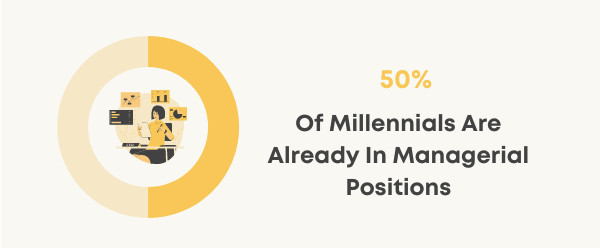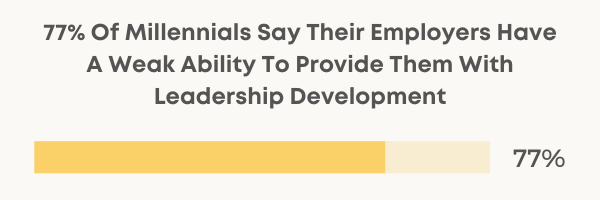Millennial leadership statistics show us how millennials are dominating the workforce at the moment.
So, how much of the workforce is made up of millennials? What percentage of millennials are managers?
Well, to find out, you should keep reading this article!
Key Millennial Leadership
Statistics (Editor’s Pick)
- 56 million of the workforce were millennials in 2017.
- Out of all millennial workers, half are already in managerial positions.
- 90% of millennials aspire to be in leadership roles.
- Only 5% of millennials are attracted to leadership because of money.
14 Millennial Leadership Statistics
1. In 2014, millennials made up the majority of the workforce.
According to Deloitte, over 50% of the workforce was made up of millennials in 2014. Furthermore, by 2025, millennials (born between 1981 and 1996) should make up 75 million of the workforce.
Source: Deloitte


2. In 2017, 56 million of the workforce were millennials.
According to Pew Research Center that analyzed U.S. Census Bureau, 56 million millennials worked in 2017. They make up 35% of the workforce, which makes them the largest generation in the U.S. workforce.
Source: Pew Research Center
3. 63% of millennials work at their jobs for 13 months or more.
More than six in 10 millennials (63%) work at their jobs for 13 months or more, compared to 60% of Generation X. Moreover, 22% of millennials and Generation X are reporting they have worked 5 or more years at their job.
Source: Pew Research Center
4. Under one in two millennials (47%) think business leaders are committed to improving society.
The majority of millennials believe that businesses only want to make money and do not have any other objectives. Furthermore, according to a Deloitte survey of millennials, only 47% of them think business leaders want to help improve society and empower others.
Source: Deloitte
5. 69% of millennials who perceive their leadership as diverse see their working environment as motivational and stimulating.
According to Deloitte research on millennials, almost seven in 10 (63%) of those who see their leadership as diverse also see their working environment as stimulating and motivating. In comparison, only 43% of those who do not have diverse leadership say the same.
Source: Deloitte
6. Half (50%) of millennials are already in managerial positions.
The number of millennials in managerial positions is growing rapidly. This is no surprise as the majority of the workforce are millennials. As it turns out, one in two millennials (50%) are already in managerial positions. Moreover, millennials appreciate approachability and transparency in business. Likewise, 33% of millennials say organizations can meet their leadership needs by providing them with an accessible and collaborative culture.
Source: Deloitte


7. Nine in 10 millennials aspire to be in leadership roles.
Almost all millennials, 91% of them, aspire to be leaders. However, 83% of them would also prefer to work for companies with fewer layers of management. These millennial leadership statistics are from Workplace Trends. Out of those who aspire to be leaders, more than half are women.
Source: Workplace Trends
8. When managers show an honest interest in millennials as people, the agility is improved 8 times and increase in innovation 7 times.
Organizations that want to succeed need to train their managers to take an interest in the millennial workforce. Why? Because the agility in the organization is improved 8 times and innovation is increased 7 times when managers show interest in millennials as people. Moreover, millennials are likely to give their best work when the companies they work for provide them with meaningful and purposeful jobs.
Source: Great Place To Work
9. One in 10 millennials are attracted to leadership because of legacy, and only 5% want leadership roles because of money.
According to Korn Ferry, only 5% of millennials want to become leaders for financial gains. On the other hand, 10% quote they are attracted to leadership because of legacy. On the other hand, most of them think leadership is about empowering others.
Source: Korn Ferry
10. Eight in 10 millennials value social purpose for a successful business, rather than financial purpose.
Research from the Harvard Business Review shows that millennials are the most socially responsible generation since the 1960s. For instance, an American Express study found that 81% of millennials cite that a successful business is one that has an honest purpose that will resonate with people, rather than a business that is all about financial gains.
Source: American Express
11. More than 80% of millennial leaders say prior leaders did not address problems of gender and racial diversity in the workplace.
While millennials do have their own struggles in managing their team members, they also struggle with things that were ignored or overlooked by their predecessors. For instance, more than 80% of millennial leaders say they struggle because of the way prior leaders did a poor job addressing problems of racial diversity and gender in the workplace.
Source: Inc.
12. Almost half of the millennials with a bachelor’s degree say they have been promoted in the past year.
Even throughout the pandemic, millennials have managed to get promoted. According to CNBC Make It/Harris Poll survey data, 47% of millennials with a bachelor’s degree got promoted in 2020, compared to 26% of those without a bachelor’s degree.
Source: CNBC Make It/Harris Poll
13. 77% of millennials say their employers have a weak ability to provide them with leadership development.
Almost eight in 10 millennials (77%) say that employers have a weak ability to provide them with leadership development, according to data from Canada. This means that millennials doubt whether their employers can even provide them with the leadership development they want.
Source: Human Resources Professional Association


14. More than six in 10 millennials think their workplace does not help them develop leadership skills.
Among the least loyal employees, Deloitte finds, that 63% of them also say their workplace does not do enough to develop their leadership skills. These finds are from statistics data in 2016.
Source: Deloitte
Final Verdict
To conclude, millennial leadership statistics tell us that millennials are starting to get leadership roles and that their generation is the largest in the workforce right now. Moreover, we can also find out about their values from the statistics and find out what they are like as leaders. Finally, leadership statistics also tell us about the state of leadership today and leadership development statistics tell us about how companies are addressing developing leaders.


































Find Us on Socials